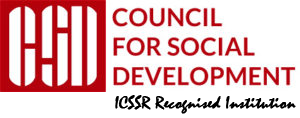National Seminar on Challenges of Growing Inequalities in India
Date: 14-15 July, 2017
Venue: India International Centre Main, New Delhi
Indian economy is growing quite rapidly in recent years. The average annual growth rate of GDP was 7.7 percent during 2004-05 to 2013-14. However, high rate of economic growth has also been associated with growing inequalities, including economic, social, regional and rural-urban inequalities. Besides, some regions and social groups, in the country continue to remain extremely poor and vulnerable, even after seven decades of independence. Still about 270 million people in the country is stated to be below the national poverty line. The average incidence of poverty is as high as 22 percent in the country and 26 percent in the rural areas. The incidence of absolute poverty in rural areas is as high as 44.6 percent in Chattisgarh, 40.8 percent in Jharkhand and 35.7 percent in Odisha and Madhya Pradesh. The Gini concentration ratio of distribution of per-capita consumption expenditure in the country which is a measure of inequality increased from 0.29 in 1964-65 to 0.34 in 2013-14. The urban – rural income ratio increased from 4.2 in 1951-52 to 9.7 in 2014-15. The co-efficient of inter – regional variation in per – capita income increased from 29.8 percent in 2004-05 to 39.2 percent in 2014-15. The poverty and indebtedness among people belonging to SCs, STs women and other vulnerable groups are relatively higher than others. Access to property rights, quality education, employment, credit and in decision making role, is comparatively lower for these vulnerable groups. All these facts raise a doubt whether the present high level of inequalities and growing economic, social, regional and rural – urban disparities will pose a challenge to India’s high rate of economic growth and democratic system of governance in the long run.
There is enough research evidence from the globe that equity is complementary, in some fundamental respects to the pursuit of long term prosperity. Institutions and policies that promote a level playing field – where all members of society have similar chances to become economically productive, socially active and politically influential contribute to sustainable growth and development. Conversely, the adverse effects of unequal economic opportunities and political power on development can prove damaging because economic, social and political inequalities tend to reproduce themselves over time and across generations. Disadvantaged children from poor and socially excluded families at the bottom do not have the same opportunities as children from rich families to receive quality education and therefore, they can only expect to earn less as adults and fall prey to ‘inequality traps’ and stay perpetually poor and marginalized. With imperfect markets, inequalities in wealth and power translate into unequal opportunities, leading to underutilization of productive potentials and inefficient allocation of resources, while an equitable growth process results in more efficient economic functioning, reduced social conflicts, greater social cohesiveness and better institutions with dynamic benefits for investment and growth.
Also not many people would accept that high level of inequalities would be tolerable when based on gender, inherited wealth, ethnicity or place of birth, caste and religion over which individuals have no control. Besides, persistent inequalities produce strong backwash effects that may wash away the benefits of any short term gains of inequitous growth process. Many democratic countries therefore, to-day adopt complimentary policies for safety net and special programmes for development of the poor and the marginalized. In India too, a policy of positive discrimination for persons, belonging to scheduled castes, scheduled tribes, and women have been accepted in principle, though less in practice and effect. During the last seven decades after independence, the condition of certain social groups and geographical regions in the country has not improved much. They are in poverty trap as well as inequality trap. Inequalities of all types are increasing. Therefore, we need to find out the pitfalls in our policy approaches and programmes and also alternative policy framework that would work better for the balanced economic growth of all sections of our population. We need to develop appropriate policies which create opportunities and incentives for all Indian citizens to invest, innovate and grow. Policies can contribute to the move from an ‘inequality trap’ to a virtuous circle of equality and sustainable growth, through greater investment in the human resources of the poorest, greater and more equal access to public services and information, guarantees on property rights and employment for all and greater fairness in the functioning of land, labour, capital and product markets. However, there are several challenges to such transformative reforms. In view of the above facts, the Council for Social Development proposes to organize a National Seminar on Challenges of Growing inequalities in India, at the India International Centre Annexe, New Delhi, on July 14-15, 2017. About 70 experts, including economists and other social scientists, concerned government officials, (comprising both present and retired) and social activists will participate.
The tentative topics for discussions would include the following:
- Challenges of growing economic inequality.
- Challenges of regional and rural-urban disparities.
- Ensuring social inclusion of Dalits, Adivasis and other marginalized groups.
- Dealing with gender inequality, especially in respect of access to property rights, education, employment, health care, credit, technology etc.
- Assessing the impact of various Govt. policies and programmes on inequality such as RTE, MGNREGA, ICDS, Mid-day Meal, FRA, NHM, PMAY, NLM, NSAP, and other SC,ST, women and minority related programmes.
Programme: read more…
